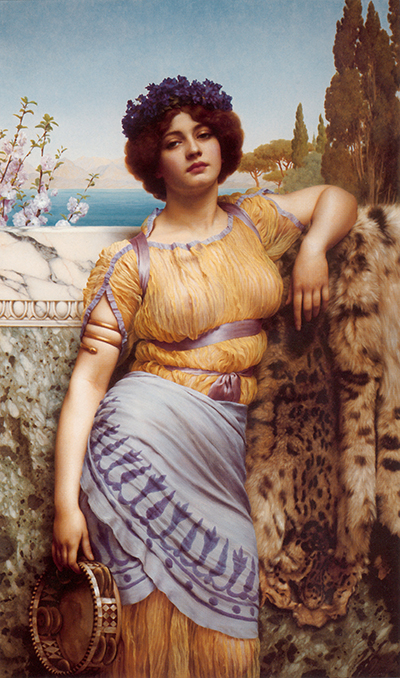The Ionian Dancing Girl was one of the many artworks of by John William Godward. It was finished in 1902 in a transitional era between the Victorian and the Neoclassicism.
The design and inspiration for the art had a lot to do with the classic way of living, that is contemporary thinking and the birth of scientific thought. The painting is a portrait of a young woman, probably from an Arabic origin as depicted from the skin tone and colour of her hair. Her dress is light, and her arm ring looks identical like the ones found in the Arabian world. There is a belly dance waist scarf around her waist while her right hand is holding a tambourine. There is also a purple vail on her head, and her face shows some exhaustion which is a sign that she is resting after a dancing performance. The raised walls and the vegetation points to a probability that the picture was in a backyard. The background has sea with Desert Mountains on the horizon.
The painting was done on a canvas with oil. The smoothness of this painting shows that Godward had a keen eye to detail and the neoclassical style helped him picture events with a high degree of finesse. Being an Englishman, the exposure to beautiful things in life and adventures made his perception of art grow holistically. This can be seen in his subsequent drawings. The Ionian Dancing Girl is now in the William O. Brisben collection in the United States.
His art has in numerous occasions been compared to Alma-Tadema, another Victorian. They both had stints at the Royal Academy. His movement to Rome is believed to have influenced his neoclassical paintings. Most of his paintings were of women with great dresses. Godward attention to the style, fashion and choice of the dresses in his paintings showed his architectural prowess. Around the time he painted the Ionian Dancing Girl, most of his arts revolved around ladies with impeccable dressing. Among them were The Jewel Casket (1900), Youth and Time (1901), Summer Flowers (1903), In the Days of Sappho (1904) and The Tambourine Girl (1906).




